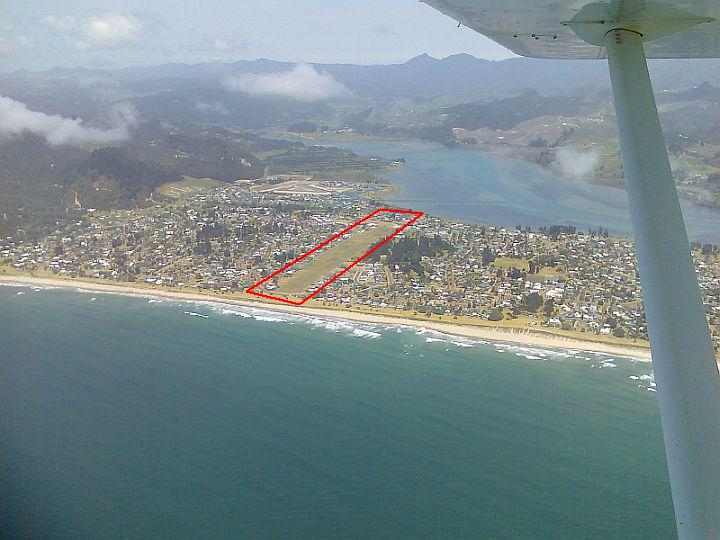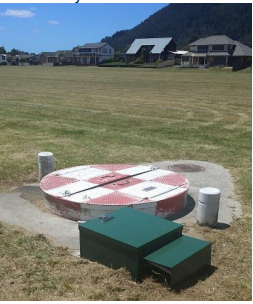Pāuanui Beach Aerodrome (NZUN)

Administration and Control
Thames-Coromandel District Council (TCDC) is the owner and operator of the Pāuanui Beach Aerodrome.
Address: Thames-Coromandel District Council, 515 MacKay Street, Thames 3500
For further information call us on (07) 868 0200 or email customer.services@tcdc.govt.nz
Complaints should be made in writing to Thames-Coromandel District Council.
Overview
Pauanui Beach Aerodrome (NZUN) splits the coastal township of Pauanui Beach.
The Airfield has a grass strip 850 x 60m and a taxi area on the southern side. Signposted aircraft parking areas are at either end of the airfield and a passenger pick-up and drop-off area is on the western end at the flight office. The surface is grass on sand and usable even in wet weather. There are no clubrooms or fuel available. The Pauanui Village Centre with cafes and other facilities is a 500m walk to the southwest.
The aerodrome is next to the golf course and is lined with beach houses, some of which have a hangar on the lower floor and most of which have aircraft tie-down points in the yard.
There is a surf beach at the eastern end of the runway, and an estuary beach with calmer conditions to the western end. Pauanui is a popular destination for light aircraft flying in for a swim or lunch at the cafes.
AIP Link (Aeronautical Information)
gen3_1 (aip.net.nz) Aerodrome
gen3_1 (aip.net.nz) Operational Data
gen2_1 (aip.net.nz) RNP 248
General Operations - Fixed and Rotary Wing
*The airfield is closed when mowing is being undertaken*
1. Grass on sand base erodes in dry weather. Where possible, pilots should keep to grassy areas. Full strip width available.
2. Park nose in and as close to the south boundary as possible to avoid side clearance infringement.
3. Noise abatement — due to the proximity of residents, aircraft movements should be avoided before 0730 LMT.
4. AWIB 130.6 MHz, activated by 4 transmissions.
5. CAUTION: Moderate to severe turbulence and windshear is expected in S, SE and NW winds.
6. Model aircraft flying may take place at any time, often in the evenings.
7. While pedestrian traffic is prohibited on the airfield, people often ignore the warnings.
8. Pedestrians and dogs may cross or stray onto the airfield at any time, especially during the evening.
9. Vehicles may be on the airfield carrying out routine inspections early morning during holiday periods and grass mowing at other times.
10. The north edge of the runway has a line of eight concrete valve pits 1.5m in diameter protruding 200mm above the surface. The runway edge is 6m from the fence line to avoid the valve pits.
ELEV 19
Radio frequency: 124.5
S 37 01 18 E 175 51 49
Aerodrome and Weather Information Broadcast (AWIB)
Pāuanui Beach Aerodrome (NZUN) has an AWIB that transmits on 130.6 MHz. To initiate the AWIB, depress the transmit button four (4) times in quick succession. The information currently transmitted includes surface wind (speed and direction)
Pāuanui Beach Aerodrome landing fees
Payment options for landing fees:
-
Honesty box on site
-
By internet banking - Bank account 01-0455-0090620-00. Particulars - enter six zeroes followed by the planes three letter registration mark. Code - your surname. Reference - Pauanui
-
Scan the QR code and follow the prompts to make payment
A recording system is installed and operational which monitors aircraft movements into and out of Pauanui Beach Aerodrome.
Fees and Charges - Schedule of Fees and Charges: Airfields | TCDC
TERRAIN
There is high terrain to the south of the aerodrome and rising terrain to the west toward the Hikuai Valley and Coromandel ranges.
SIGNIFICANT WEATHER
Weather conditions are generally favourable throughout the year.
The surface can be soft after heavy rain and during winter months in some areas of the airfield, particularly in the area between the western end threshold marker and the end of the western end of the airfield.
In conditions where light south-westerly winds prevail, midafternoon sea-breeze conditions can create a situation where tail winds occur at both ends of the runway. Awareness of the windsocks on the final approach is recommended.
Prevailing easterly or south easterly winds produce low clouds and drizzle which may remain for 2-3 days.
Moderate northerly or southerly winds flowing over buildings and through the trees to the north/south of the runway will produce mechanical turbulence and windshear on final approach to both runway 05 and 23.
At any time of the year however, particularly between June and October, in airflows from north through east to southeast, low clouds and poor visibility is common inland of the coast.
GROUND THREATS
Pedestrians/Golfers
While every attempt is made to keep pedestrian traffic from crossing or walking out onto the airfield, inevitably people may take the "short cut" to get to the other side. Golfers from the golf course on the northern side of the airfield may stray on to the airfield to retrieve golf balls. Keep a good look out for pedestrians at all times but particularly over summer holiday periods. Visibility in the early morning or late evening makes identification of pedestrians on the airfield very difficult.
UNDERGROUND IRRIGATION SYSTEM
An underground irrigation system has been laid under the grass runway that incorporates a network of drip lines that are fed by valve heads. These valve heads are on the northern edge of the runway and sit proud of the ground along with the associated meter cabinets. Whilst they are low to the ground, they can be taxied into or landed on if aircraft are too close to the northern edge of the airstrip. All taxiing is to be conducted on the southern side of the strip where possible.
Thames-Coromandel District Council contractors are required to maintain the irrigation system and valve pits and access the airfield to undertake this work. They operate in vehicles that have an orange rotating hazard light on top and keep a good lookout for aircraft if required to cross the runway.

VALVE HEADS
Whilst they are low to the ground, they can be taxied into or landed on if aircraft are too close to the northern edge of the airstrip. All taxiing is to be conducted on the southern side of the strip where possible.